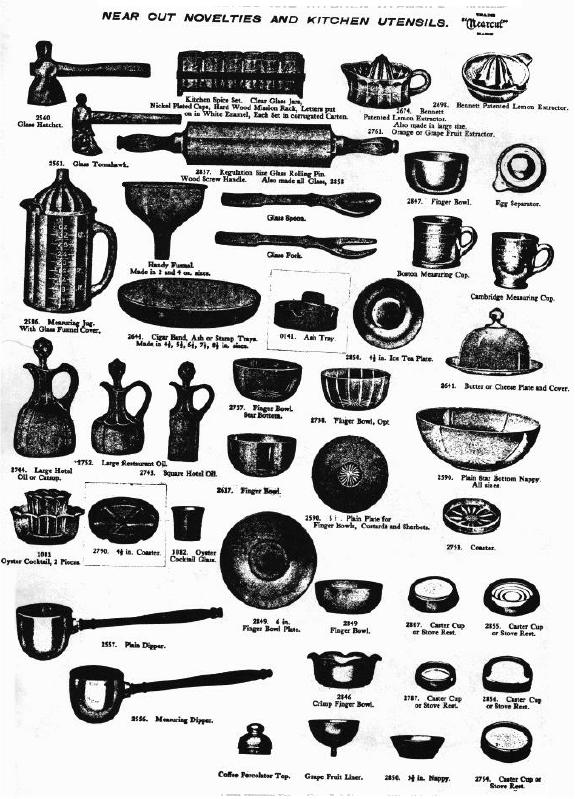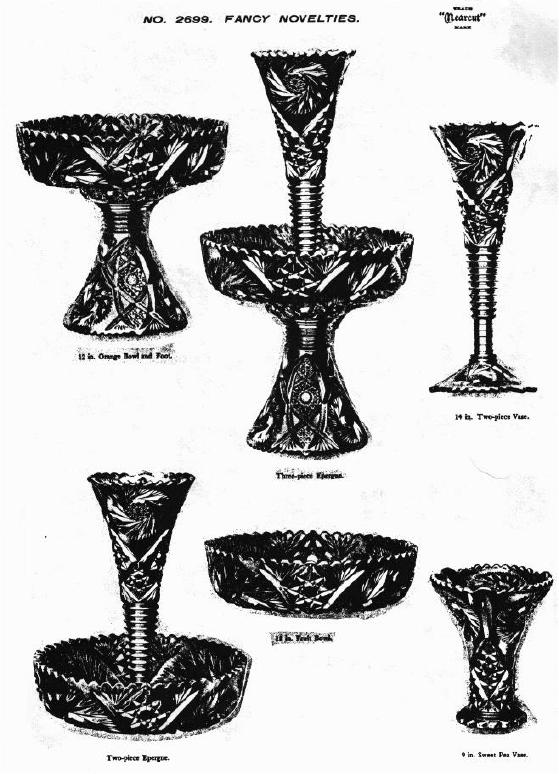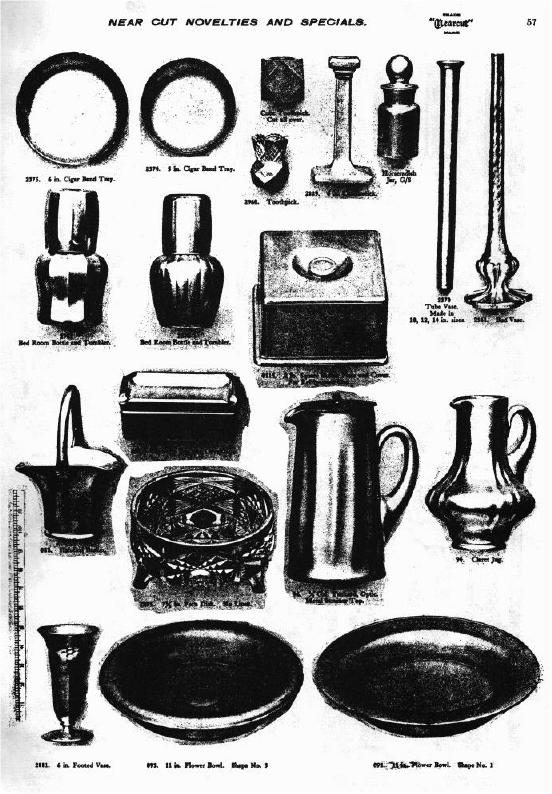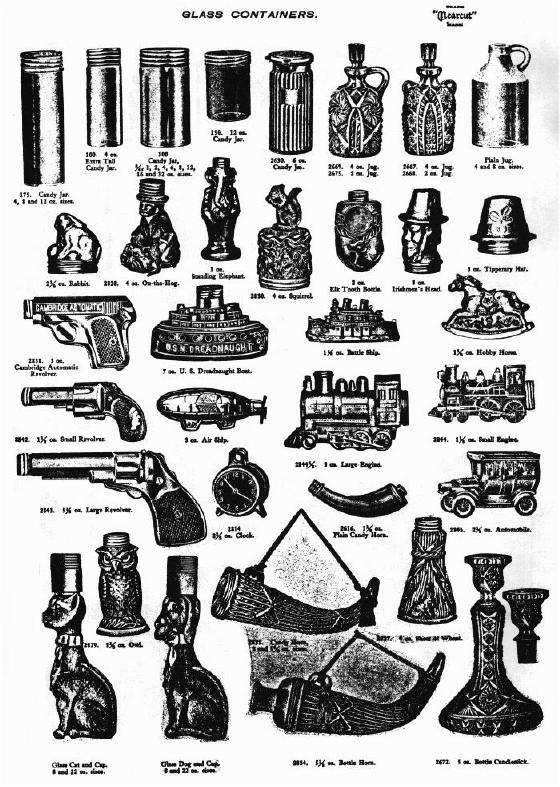Novelty Items, Part IV
by Mark A. Nye
Issue No. 230 - June 1992
The Cambridge "General Catalog of Pressed and Iron Mold Blown Glassware" issued circa 1917-1918 contained several pages of novelty items. Not all of these pages were labeled as Novelties, but on those that were not, the items shown are, without question, novelties.
On the attached page, entitled "Near Cut Novelties and Kitchen Utensils" a wide variety of items were illustrated. While some of the items shown were, without question, of Cambridge origin (for example the Bennett juice extractors), others were no doubt made using molds first used by other factories. In the latter category are such items as the glass hatchet, glass tomahawk and the measuring jug with glass funnel cover. These molds could have been brought to Cambridge from other factories in the National Glass Company consortium at the time of its founding or shortly thereafter.
With the exception of the juice extractors, most of the items seen on this page are seldom found today, partly because they are virtually impossible to identify as being of Cambridge origin. For instance, looking at the "handy funnel" or the coffee percolator top illustrations would you recognize either of these as being Cambridge?
The big question about this page is which items Cambridge considered novelties and which are simply kitchen utensils. Most certainly the hatchet and tomahawk are novelties; and I would call the measuring jug with glass funnel cover a novelty. On the other hand, by no stretch of the imagination could such items as finger bowls and measuring cups be called novelties. Debatable items include the castor cups or stove rests, and the glass fork and spoon.
The fate of all the molds used to produce the items seen on this page has yet to be determined. It is known the molds for the Cambridge and Boston measuring cups were destroyed during the early 1940s, as were those used to produce the #2560 hatchet and the egg separator.
A page with the heading "No 2699 Fancy Novelties" (see accompanying pictures) illustrated five items from the Buzz Saw line. While at first glance these might not be thought of as novelties, a closer look reveals that three of the items are assembled using the other three; and that is probably the reason Cambridge referred to them as novelties. Catalog No 10, issued approximately two years later, did not refer to these pieces as novelties and simply included them with the balance of the Buzz Saw line.
The third page (see accompanying pictures) labeled as showing novelties, this one captioned "Near Cut Novelties and Specials", presents a problem. What are the novelties? The tube and bud vases are unique in their shapes; a claret jug is certainly not a common item, nor are cigar band trays. Do these qualify as novelties? Yes, they probably do.
Figural glass candy containers are generally thought of as novelties, and in 1918 Cambridge was offering a wide selection. (See accompanying pictures) Not all of the items shown on this catalog page, entitled "Glass Containers" were for candy, however. Included among the 25 candy containers illustrated were: three jugs; the #2672 bottle candlestick; the dog and cat bottles; a bottle horn; and the #2827 4 oz. Sheaf of Wheat. Identified prior to its appearance on this catalog page as a candy bottle, the Sheaf of Wheat was later identified on a Cambridge factory list of molds destroyed, as a shaker. In this appearance, however, it was being promoted as a candy container.
During its early years, the Cambridge Glass Company issued a number of catalogs, both general and specialty, and not all of these are known today. Thus, we cannot be sure when the figural candy containers were first made. Those containers with item numbers in the #2600 and #2800 series are probably of Cambridge origin. That is, the molds were created by Cambridge and most likely first made between 1915 and 1918. It is possible, however, these candy containers were in production prior to 1915. Whether or not all those containers that have no item number were designed by Cambridge has not been determined. It is very possible some of them were not.
An early reference to four of the items: the Sheaf of Wheat, the Owl candy bottle, the On-the-Hog candy bottle and the Squirrel candy bottle, contained the following note.
"Something Entirely New is Candy Bottles. As these are new and have never been made we can only estimate capacity. All fitted with Metal Screw Cap."
However, the reference, which comes from an unidentified source, was illustrated. Since the items had not been made, it is hard to tell what was used for the illustrations. Most likely it was the models from which the molds were made.
While Cambridge did make a glass clock body, purchase works and sell a glass clock (it also being a novelty item), this is not the clock shown on the glass container page. This clock is another of the glass figural candy containers.
How long the figural candy containers, which were probably made mostly in crystal, remained in the Cambridge line, is not known. None of them appeared in the Catalog No. 10 issued in 1920 or in later Cambridge catalogs. Not being illustrated in Catalog No. 10 does not necessarily mean all of the candy containers had been discontinued by 1920, but it is an indication. They were probably out of the Cambridge line by 1927 and at the latest by 1930.
The molds for the Tipperary Hat, the Sheaf of Wheat and the Revolvers were destroyed during the early 1940s. The molds for the balance of the figural candy containers do not appear on the 1955 mold inventory list. It is unlikely they were overlooked during the inventory and thus were no longer in existence at the time the inventory was taken. As yet, it has not been determined if the molds were destroyed prior to 1940 or sometime during the middle to late 1940s.
In addition to the candy containers, several other novelty items also appeared on the same catalog page. The #2834 bottle horn is simply the large size candy horn with a different top. The #2672 bottle candlestick was covered in the first article of this series and the cat and dog bottles await a future article.




